Analysis of Psychoacoustic and Vibration-Related Parameters to Track the Reasons for Health Complaints after the Introduction of New Tramways
Abstract
:1. Introduction
2. Materials and Methods
2.1. Areas of Investigation, Tramway Types and Sound (Psychoacoustic) Recordings
2.2. Vibration Recordings
2.3. Calculation and Analysis of Objective Parameters
3. Results
4. Discussion
5. Conclusions
Acknowledgments
Author Contributions
Conflicts of Interest
Appendix A
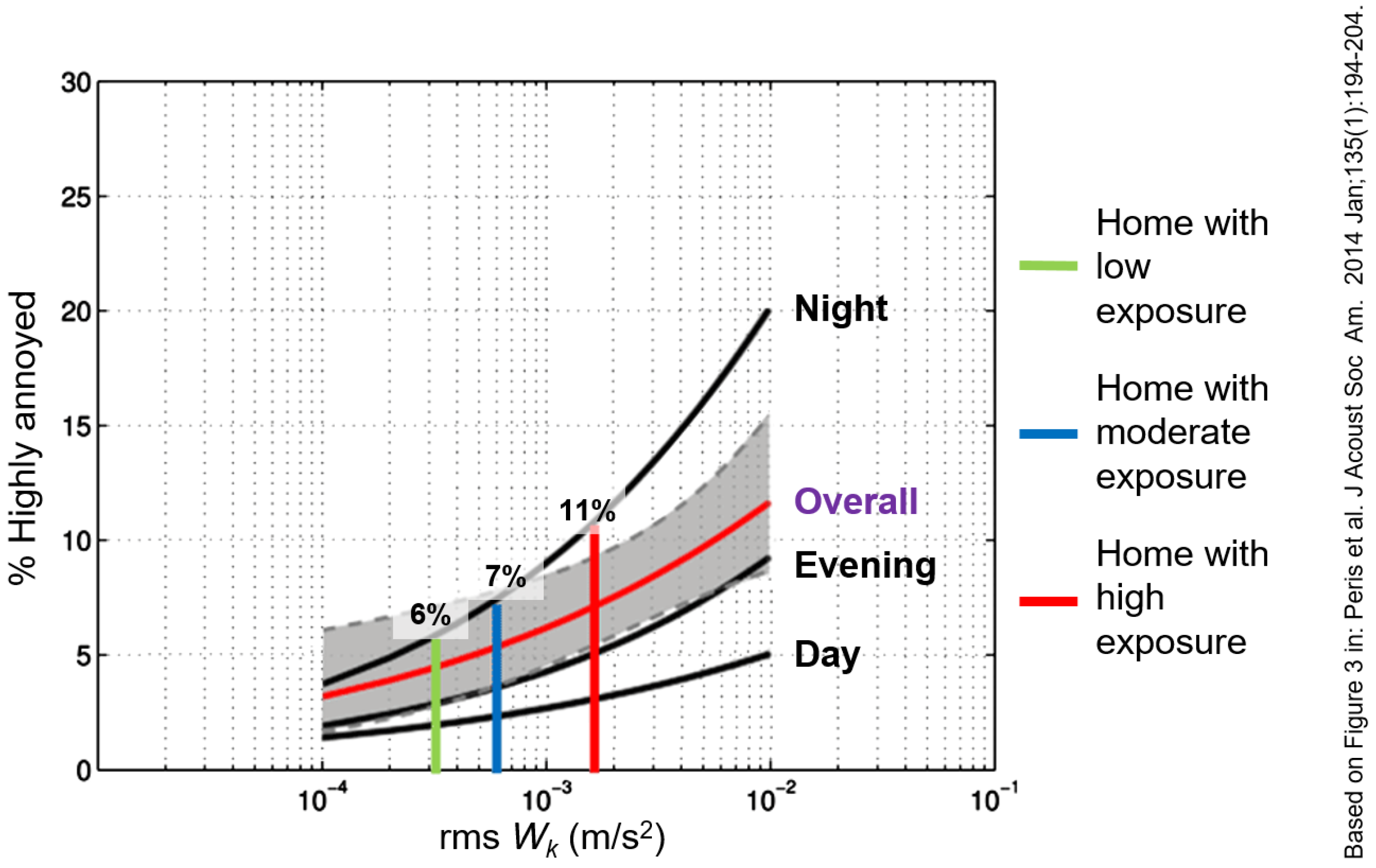

| Measuring Points | Type of Tramway | Measured Tramways | Wm Weighted Peak Acceleration (SLOW) (m/s2) Mean | Wm Weighted Peak Acceleration (SLOW) (m/s2) SD | Wm Weighted Peak Acceleration (FAST) (m/s2) Mean | Wm Weighted Peak Acceleration (FAST) (m/s2) SD |
|---|---|---|---|---|---|---|
| Measuring point 1 | New Tram | 51 | 0.0046 | 0.0005 | 0.0070 | 0.0009 |
| Old Tram | 14 | 0.0041 | 0.0002 | 0.0062 | 0.0003 | |
| Measuring point 2 | New Tram | 41 | 0.0041 | 0.0002 | 0.0063 | 0.0003 |
| Old Tram | 19 | 0.0041 | 0.0002 | 0.0063 | 0.0003 | |
| Measuring point 3 | New Tram | 70 | 0.0061 | 0.0006 | 0.0091 | 0.0014 |
| Old Tram | 2 | 0.0053 | 0.0004 | 0.0077 | 0.0001 | |
| Measuring point 4 | New Tram | 31 | 0.0066 | 0.0023 | 0.0099 | 0.0031 |
| Old Tram | 18 | 0.0055 | 0.0011 | 0.0086 | 0.0021 | |
| Measuring point 5 | New Tram | 74 | 0.0069 | 0.0020 | 0.0099 | 0.0029 |
| Old Tram | 45 | 0.0060 | 0.0013 | 0.0089 | 0.0021 | |
| Measuring point 6 | New Tram | 51 | 0.0050 | 0.0008 | 0.0076 | 0.0011 |
| Old Tram | 26 | 0.0047 | 0.0007 | 0.0073 | 0.0009 |
| Type of tram | % above Threshold * | Lower 95% CI | Upper 95% CI |
|---|---|---|---|
| Variobahn (“new”) | 47% | 41% | 52% |
| CityRunner (“old”) | 20% | 12% | 29% |
| Series 500-600 (“very old”) | 32% | 19% | 49% |
References
- Hodgson, P.; Potter, S.; Warren, J.; Gillingwater, D. Can bus really be the new tram? Res. Trans. Econ. 2013, 39, 158–166. [Google Scholar] [CrossRef]
- De Bruijn, H.; Veeneman, W. Decision-making for light rail. Trans. Res. A Policy Pract. 2009, 43, 349–359. [Google Scholar] [CrossRef]
- Scherer, M. Is light rail more attractive to users than bus transit? Trans. Res. Rec. J. Trans. Res. Board 2010, 2144, 11–19. [Google Scholar] [CrossRef]
- Mingardo, G. Transport and environmental effects of rail-based Park and Ride: Evidence from the Netherlands. J. Trans. Geogr. 2013, 30, 7–16. [Google Scholar] [CrossRef]
- Wijnia, Y.K. Noise emission from trams. J. Sound Vib. 1988, 120, 281–286. [Google Scholar] [CrossRef]
- Mandula, J.; Salaiová, B.; Kovalaková, M. Prediction of noise from trams. Appl. Acoust. 2002, 63, 373–389. [Google Scholar] [CrossRef]
- Pallas, M.A.A.; Lelong, J.; Chatagnon, R. Characterisation of tram noise emission and contribution of the noise sources. Appl. Acoust. 2011, 72, 437–450. [Google Scholar] [CrossRef]
- Van Ruiten, C.J.M. Mechanism of squeal noise generated by trams. J. Sound Vib. 1988, 120, 245–253. [Google Scholar] [CrossRef]
- Vincent, N.; Koch, J.R.; Chollet, H.; Guerder, J.Y. Curve squeal of urban rolling stock—Part 1: State of the art and field measurements. J. Sound Vib. 2006, 293, 691–700. [Google Scholar] [CrossRef]
- Kaczmarek, T. Squeal Tram Noise Annoyance; Euronoise: Tampere, Finland, 2006. [Google Scholar]
- Kaczmarek, T.; Hafke, H.; Preis, A.; Sandrock, S.; Griefahn, B.; Gjestland, T. The tram bonus. Arch. Acoust. 2006, 31, 405–412. [Google Scholar]
- Trollé, A.; Marquis-Favre, C.; Klein, A. Short-term annoyance due to tramway noise: Determination of an acoustical indicator of annoyance via multilevel regression analysis. Acta Acust. United Acust. 2014, 100, 34–45. [Google Scholar] [CrossRef]
- Sandrock, S.; Griefahn, B.; Kaczmarek, T.; Hafke, H.; Preis, A.; Gjestland, T. Experimental studies on annoyance caused by noises from trams and buses. J. Sound Vib. 2008, 313, 908–919. [Google Scholar] [CrossRef]
- Miedema, H.M.E.; van den Berg, R. Community response to tramway noise. J. Sound Vib. 1998, 120, 341–346. [Google Scholar] [CrossRef]
- Philipps-Bertin, C.; Champelovier, P.; Lambert, J.; Trindade, C.; Legouis, T. Perception and annoyance due to tramway noise. In INTER-NOISE and NOISE-CON Congress and Conference Proceedings; Institute of Noise Control Engineering: Reston, VA, USA, 2007. [Google Scholar]
- Trollé, A.; Marquis-Favre, C.; Klein, A. Acoustical indicator of noise annoyance due to tramway in in-curve operating configurations. In Proceedings of the 2013 3rd International Conference on Instrumentation Control and Automation, Meetings on Acoustics, Montreal, QC, Canada, 2–7 June 2013.
- Kouroussis, G.; Connolly, D.P.; Verlinden, O. Railway-induced ground vibrations—A review of vehicle effects. Int. J. Rail. Trans. 2014, 2, 69–110. [Google Scholar] [CrossRef]
- Maldonado, M.; Chiello, O.; Houédec, D. Propagation of Vibrations Due to a Tramway Line. In Noise and Vibration Mitigation for Rail Transportation Systems; Springer: Berlin/Heidelberg, Germany, 2008. [Google Scholar]
- Real Herráiz, J.I.; Morales-Ivorra, S.; Zamorano Martín, C.; Soler Basauri, V. Analysis of Vibrations Generated by the Presence of Corrugation in a Modeled Tram Track. In Mathematical Problems in Engineering; Hindawi Publishing Corporation: Cairo, Egypt, 2015. [Google Scholar]
- Jolibois, A.; Defrance, J.; Koreneff, H.; Jean, P.; Duhamel, D.; Sparrow, V.W. In situ measurement of the acoustic performance of a full scale tramway low height noise barrier prototype. Appl. Acoust. 2015, 94, 57–68. [Google Scholar] [CrossRef] [Green Version]
- Lang, J. Ground-borne vibrations caused by trams, and control measures. J. Sound Vib. 1998, 120, 407–412. [Google Scholar] [CrossRef]
- Kouroussis, G.; Pauwels, N.; Brux, P.; Conti, C.; Verlinden, O. A numerical analysis of the influence of tram characteristics and rail profile on railway traffic ground-borne noise and vibration in the Brussels Region. Sci. Total Environ. 2014, 482–483, 452–460. [Google Scholar] [CrossRef] [PubMed]
- Connolly, D.P.; Marecki, G.P.; Kouroussis, G.; Thalassinakis, I.; Woodward, P.K. The growth of railway ground vibration problems—A review. Sci. Total Environ. 2016, 568, 1276–1282. [Google Scholar] [CrossRef] [PubMed]
- Paulsen, R.; Kastka, J. Effects of combined noise and vibration on annoyance. J. Sound Vib. 1995, 181, 295–314. [Google Scholar] [CrossRef]
- Waddington, D.C.; Woodcock, J.; Peris, E.; Condie, J.; Sica, G.; Moorhouse, A.T.; Steele, A. Human response to vibration in residential environments. J. Acoust. Soc. Am. 2014, 135, 182–193. [Google Scholar] [CrossRef] [PubMed]
- Turunen-Rise, I.H.; Brekke, A.; Harvik, L.; Madshus, C.; Klaeboe, R. Vibration in dwellings from road and rail traffic—Part I: A new Norwegian measurement standard and classification system. Appl. Acoust. 2003, 64, 71–87. [Google Scholar] [CrossRef]
- Klæboe, R.; Turunen-Rise, I.H.; Hårvik, L.; Madshus, C. Vibration in dwellings from road and rail traffic—Part II: Exposure–effect relationships based on ordinal logit and logistic regression models. Appl. Acoust. 2003, 64, 89–109. [Google Scholar] [CrossRef]
- Peris, E.; Woodcock, J.; Sica, G.; Sharp, C.; Moorhouse, A.T.; Waddington, D.C. Effect of situational, attitudinal and demographic factors on railway vibration annoyance in residential areas. J. Acoust. Soc. Am. 2014, 135, 194–204. [Google Scholar] [CrossRef] [PubMed]
- Sharp, C.; Woodcock, J.; Sica, G.; Peris, E.; Moorhouse, A.T.; Waddington, D.C. Exposure-response relationships for annoyance due to freight and passenger railway vibration exposure in residential environments. J. Acoust. Soc. Am. 2014, 135, 205–212. [Google Scholar] [CrossRef] [PubMed]
- Smith, M.G.; Croy, I.; Ögren, M.; Waye, K.P. On the Influence of Freight Trains on Humans: A Laboratory Investigation of the Impact of Nocturnal Low Frequency Vibration and Noise on Sleep and Heart Rate. PLoS ONE 2013, 8, e55829. [Google Scholar] [CrossRef] [PubMed]
- Croy, I.; Smith, M.G.; Waye, K.P. Effects of train noise and vibration on human heart rate during sleep: An experimental study. BMJ Open 2013, 3, e002655. [Google Scholar] [CrossRef] [PubMed]
- Woodcock, J.; Moorhouse, A.T.; Waddington, D.C. A multidimensional evaluation of the perception and annoyance caused by railway induced groundborne vibration. Acta Acust. United Acust. 2014, 100, 614–627. [Google Scholar] [CrossRef]
- Zapfe, J.A.; Saurenman, H.; Fidell, S. Ground-Borne Noise and Vibration in Buildings Caused by Rail Transit. Ground. Web-Only Document 48. Available online: http://onlinepubs.trb.org/onlinepubs/tcrp/tcrp_web-doc_48.pdf (accessed on 10 November 2016).
- Peris, E.; Woodcock, J.; Sica, G.; Sharp, C.; Moorhouse, A.T.; Waddington, D.C. Guidance for new policy developments on railway noise and vibration. Trans. Res. A Policy Pract. 2016, 85, 76–88. [Google Scholar] [CrossRef]
- Siemens, A.G. Avenio Tram—Munich, Germany. Available online: http://www.mobility.siemens.com/mobility/global/SiteCollectionDocuments/en/rail-solutions/trams-and-light-rail/avenio-muenchen-en.PDF (accessed on 10 November 2016).
- Bombardier Transportation GmbH. Environmental Product Declaration—Flexity Outlook. Available online: http://www.bombardier.com/content/dam/Websites/bombardiercom/supporting-documents/Sustainability/Reports/BT/Bombardier-Transportation-EPD-FLEXITY-Valencia-en.pdf (accessed on 10 November 2016).
- Alstom Transportation. Citadis Spirit—The Spirit That Moves Your City. Available online: http://www.alstom.com/Global/Transport/Resources/Documents/brochure2014/Citadis%20Spirit%20-%20Brochure%20-%20EN.pdf?epslanguage=en-GB (accessed on 10 November 2016).
- Hume, K.I.; Brink, M.; Basner, M. Effects of environmental noise on sleep. Noise Health 2012, 14, 297–302. [Google Scholar] [CrossRef] [PubMed]
- Kim, R.; van den Berg, M. Summary of night noise guidelines for Europe. Noise Health 2010, 12, 61–63. [Google Scholar] [CrossRef] [PubMed]
- Griefahn, B. Sleep Disturbances Related to Environmental Noise. Noise Health 2002, 4, 57–60. [Google Scholar] [PubMed]
- Ohrstrom, E. Effects of exposure to railway noise—A comparison between areas with and without vibration. J. Sound Vib. 1997, 205, 555–560. [Google Scholar] [CrossRef]
- Gidlöf-Gunnarsson, A.; Ogren, M.; Jerson, T.; Ohrström, E. Railway noise annoyance and the importance of number of trains, ground vibration, and building situational factors. Noise Health 2012, 14, 190–201. [Google Scholar] [CrossRef] [PubMed]
- Howarth, H.V.C.; Griffin, M.J. The annoyance caused by simultaneous noise and vibration. J. Acoust. Soc. Am. 1991, 89, 2317–2323. [Google Scholar] [CrossRef]
- Lercher, P. Noise and Vibrations and other Interactions with the Environment. In Proceedings of the International Workshop on “Combined Environmental Exposure: Noise, Air Pollutants and Chemicals”; Kephalopoulos, S., Koistinen, K., Paviotti, M., Schwela, D., Kotzias, D., Eds.; Office for Official Publications of the European Communities: Ispra, Italy, 2007. [Google Scholar]
- Lercher, P. Combined Noise Exposure at Home. In Encyclopedia of Environmental Health; Elsevier: Burlington, MA, USA, 2011; pp. 764–777. [Google Scholar]
- Lee, P.J.; Griffin, M.J. Combined effect of noise and vibration produced by high-speed trains on annoyance in buildings. J. Acoust. Soc. Am. 2013, 133, 2126–2135. [Google Scholar] [PubMed]
- Cik, M.; Lercher, P. Ground-borne vibrations, sounds and secondary airborne sounds from tramways: A psychoacoustic evaluation including health aspects. In Proceedings of the 43nd International Congress and Exhibition on Noise Control Engineering, Melbourne, Australia, 16–19 November 2014.
- Beurteilung der Einwirkung von Schwingungsimmissionen des landgebundenen Verkehrs auf den Menschen in Gebäuden—Schwingungen und sekundärer Luftschall. ÖNORM S 9012. 1 February 2010.
- Leventhall, H.G. Low frequency noise and annoyance. Noise Health 2004, 6, 59–72. [Google Scholar] [PubMed]
- Messung und Bewertung Tieffrequenter Geräuschimmissionen in der Nachbarschaft. DIN 45680. March 1997; Deutsches Institut für Normung: Berlin, Germany.
- Sottek, R. Gehörgerechte Rauhigkeitsberechnung; DAGA: Dresden, Germany, 1994. [Google Scholar]
- World Health Organization Europe. Night Noise Guidelines for Europe; World Health Organization Europe: Geneva, Switzerland, 2009. [Google Scholar]
- Kjellberg, A.; Tesarz, M.; Holmberg, K.; Landström, U. Evaluation of frequency-weighted sound level measurements for prediction of low-frequency noise annoyance. Environ. Int. 1997, 23, 519–527. [Google Scholar] [CrossRef]
- Rushforth, I.; Moorhouse, A.; Styles, P. A case study of low frequency noise assessed using din 45680 criteria. Noise Notes 2004, 3, 3–18. [Google Scholar] [CrossRef]
- Schomer, P.D. Criteria for assessment of noise annoyance. Noise Contr. Eng. J. 2005, 53, 132–144. [Google Scholar] [CrossRef]
- Basner, M.; Brink, M.; Bristow, A.; de Kluizenaar, Y.; Finegold, L.; Hong, J. ICBEN review of research on the biological effects of noise 2011–2014. Noise Health 2015, 17, 57. [Google Scholar] [CrossRef] [PubMed] [Green Version]
- Fidell, S.; Teffeteller, S. Scaling the annoyance of intrusive sounds. J. Sound Vib. 1981, 78, 291–298. [Google Scholar] [CrossRef]
- Schomer, P.D.; Wagner, L.R. On the contribution of noticeability of environmental sounds to noise annoyance. Noise Contr. Eng. J. 1996, 44, 294–305. [Google Scholar] [CrossRef]
- Sneddon, M.; Pearsons, K.; Fidell, S. Laboratory study of the notice-ability and annoyance of low signal-to-noise ratio sounds. Noise Contr. Eng. J. 2003, 51, 300–305. [Google Scholar] [CrossRef]
- Roberts, M.J.; Western, A.W.; Webber, M.J. A theory of patterns of passby noise. J. Sound Vib. 2003, 262, 1047–1056. [Google Scholar] [CrossRef]
- Bockstael, A.; Coensel, B.D.; Lercher, P.; Botteldooren, D. Influence of temporal structure of the sonic environment on annoyance. In Proceedings of the 10th International Congress on Noise as a Public Health Problem (ICBEN 2011), London, UK, 24–28 July 2011.
- Coensel, B.D.; Botteldooren, D.; Muer, T.D.; Berglund, B.; Nilsson, M.E.; Lercher, P. A model for the perception of environmental sound based on notice-events. J. Acoust. Soc. Am. 2009, 126, 656–665. [Google Scholar] [CrossRef] [PubMed]
- Klein, A.; Marquis-Favre, C.; Weber, R.; Trollé, A. Spectral and modulation indices for annoyance-relevant features of urban road single-vehicle pass-by noises. J. Acoust. Soc. Am. 2015, 137, 1238–1250. [Google Scholar] [CrossRef] [PubMed]
- Lakatos, P.; Musacchia, G.; O’Connel, M.N.; Falchier, A.Y.; Javitt, D.C.; Schroeder, C.E. The Spectrotemporal Filter Mechanism of Auditory Selective Attention. Neuron 2013, 77, 750–761. [Google Scholar] [CrossRef] [PubMed]
- Pérez-González, D.; Malmierca, M.S. Adaptation in the auditory system: An overview. Front. Integr. Neurosci. 2014, 8. [Google Scholar] [CrossRef] [PubMed]
- Shamma, S.A.; Elhilali, M.; Micheyl, C. Temporal coherence and attention in auditory scene analysis. Trends Neurosci. 2011, 34, 114–123. [Google Scholar] [CrossRef] [PubMed]
- Uppenkamp, S.; Röhl, M. Human auditory neuroimaging of intensity and loudness. Hear. Res. 2014, 307, 65–73. [Google Scholar] [CrossRef] [PubMed]
- Preis, A. Noise annoyance and its components. Arch. Cent. Sens. Res. 1995, 2, 1–54. [Google Scholar]
- Genuit, K.; Fiebig, A. Psychoacoustics and its benefit for the soundscape approach. Acta Acust. United Acust. 2006, 92, 952–958. [Google Scholar]
- Cik, M.; Lienhart, M. Soundmapping approaches in a small suburban study area. In Proceedings of the 45th International Congress and Exhibition on Noise Control Engineering (Internoise 2016), Hamburg, Germany, 21–24 August 2016.
- Trollé, A.; Marquis-Favre, C.; Parizet, E. Perception and annoyance due to vibrations in dwellings generated from ground transportation: A review. J. Low Freq. Noise Vib. Act. Contr. 2015, 34, 963–966. [Google Scholar] [CrossRef]
- Peris, E.; Woodcock, J.; Sica, G.; Moorhouse, A.T.; Waddington, D.C. Annoyance due to railway vibration at different times of the day. J. Acoust. Soc. Am. 2012, 131, EL191–EL196. [Google Scholar] [CrossRef] [PubMed]
- Woodcock, J.S.; Peris, E.; Moorhouse, A.T.; Waddington, D.C. Guidance Document for the Evaluation of Railway Vibration; CargoVibes: Salford, UK, 2014. [Google Scholar]
- Mechanical vibration and shock—Evaluation of human exposure to whole-body vibration—Part 2: Vibration in buildings (1 Hz to 80 Hz). ISO 2631-2:2003. 2003.
- Tappauf, B.; Cik, M.; Flesch, R.; Lercher, P. The Use of Vibration Health Response Information in the Framework of Environmental Health Impact Assessments: Technical Issues of Implementation and Interpretation; EuroNoise: Maastricht, The Netherlands, 2015. [Google Scholar]
- Passchier-Vermeer, W.; Zeichart, K.; Gezondheid, T.; Preventie, N.O. Vibrations in the Living Environment. Relationships between Vibration Annoyance and Vibration Metrics; TNO: Leiden, The Netherlands, 1998. [Google Scholar]
- Smith, M.G.; Ögren, M.; Hammar, O.; Persson-Waye, K. Physiological Reaction Thresholds to Vibration during Sleep; EuroNoise: Maastricht, The Netherlands, 2015. [Google Scholar]
- Takahashi, Y. A study on the contribution of body vibrations to the vibratory sensation induced by high-level, complex low-frequency noise. Noise Health 2011, 13, 2–8. [Google Scholar] [CrossRef] [PubMed]
- Takahashi, Y. Vibratory sensation induced by low-frequency noise: The threshold for “vibration perceived in the head” in normal-hearing subjects. J. Low Freq. Noise Vib. Act. Contr. 2013, 32, 1–10. [Google Scholar] [CrossRef]
- Brooks, B.M.; Schulte-Fortkamp, B.; Voigt, K.S.; Case, A.U. Exploring our sonic environment through soundscape research & theory. Acoust. Today 2014, 10, 30–40. [Google Scholar]
- Brown, A.L.; van Kamp, I. Response to a change in transport noise exposure: Competing explanations of change effects. J. Acoust. Soc. Am. 2009, 125, 905–914. [Google Scholar] [CrossRef] [PubMed]
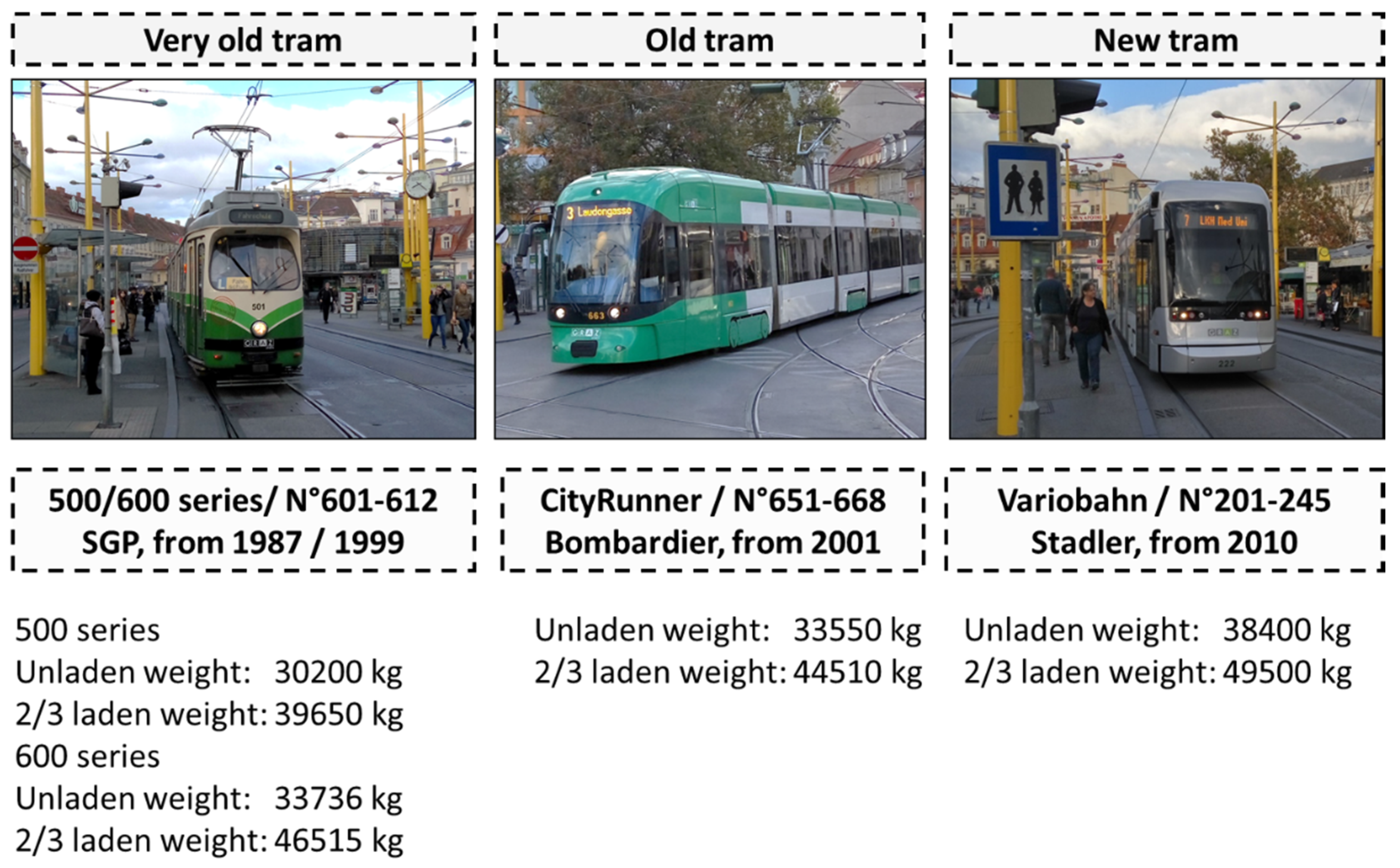
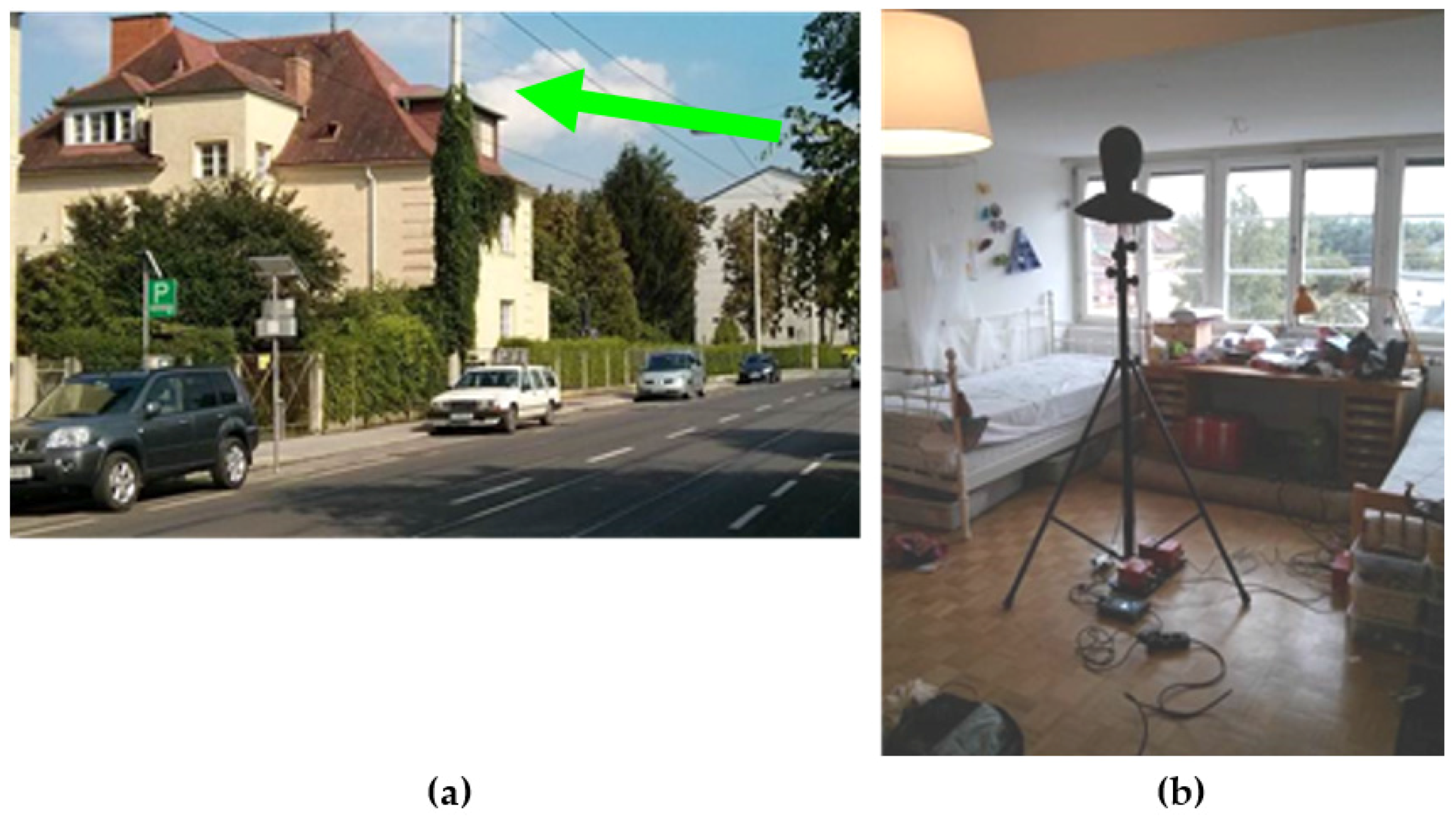
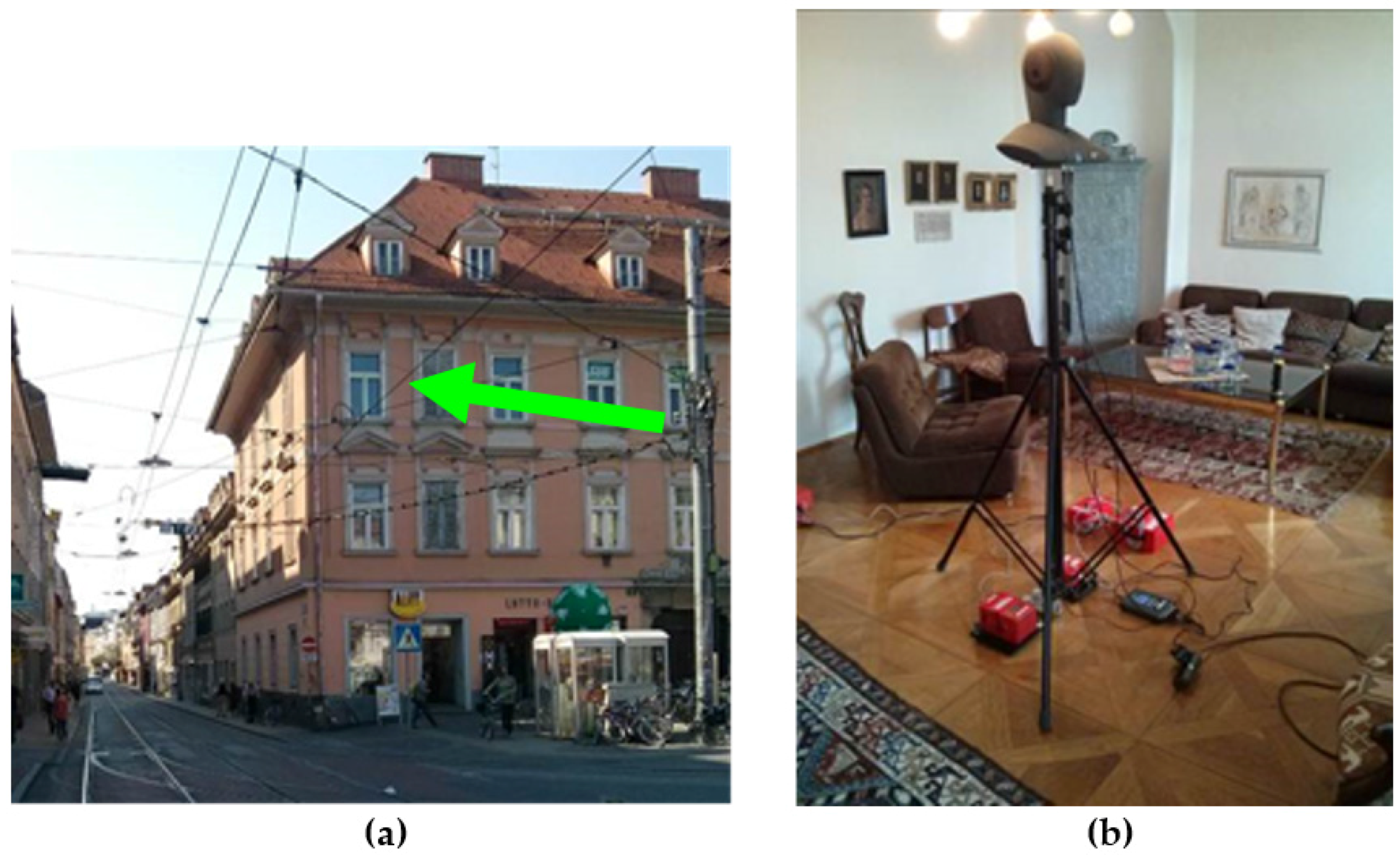
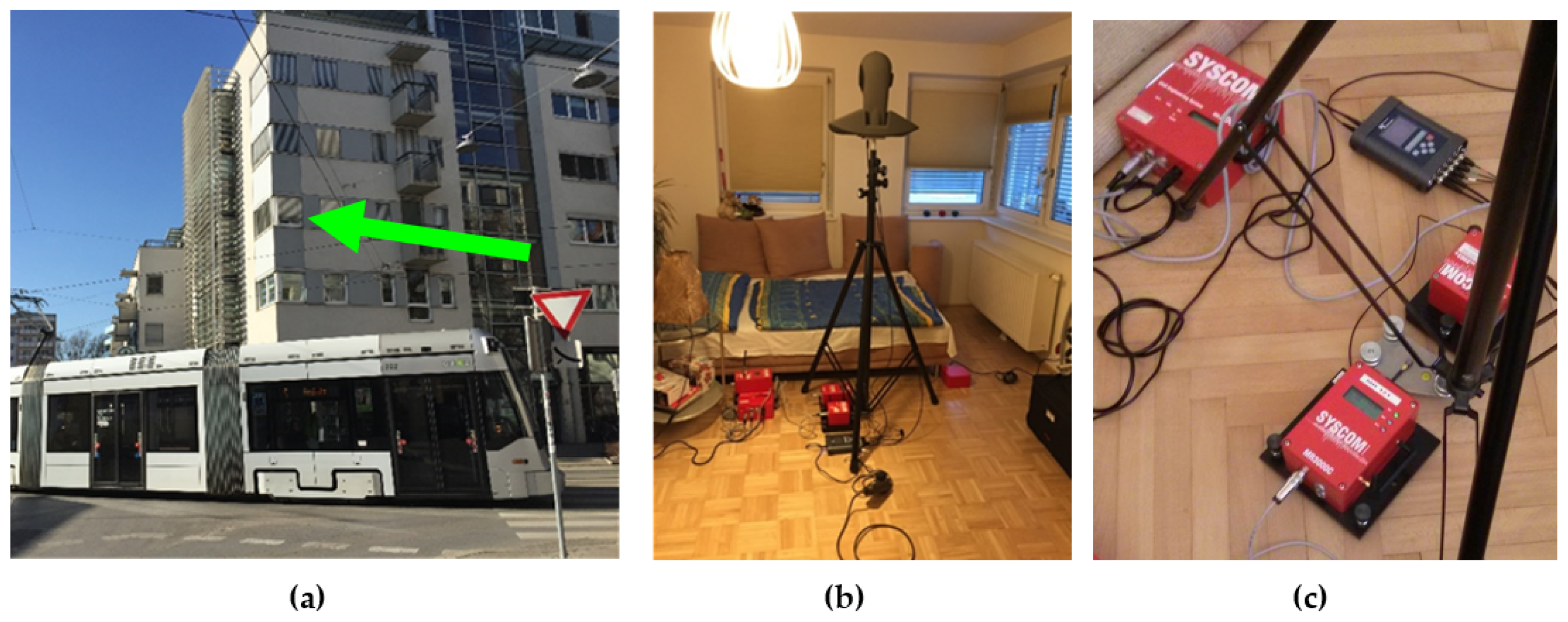
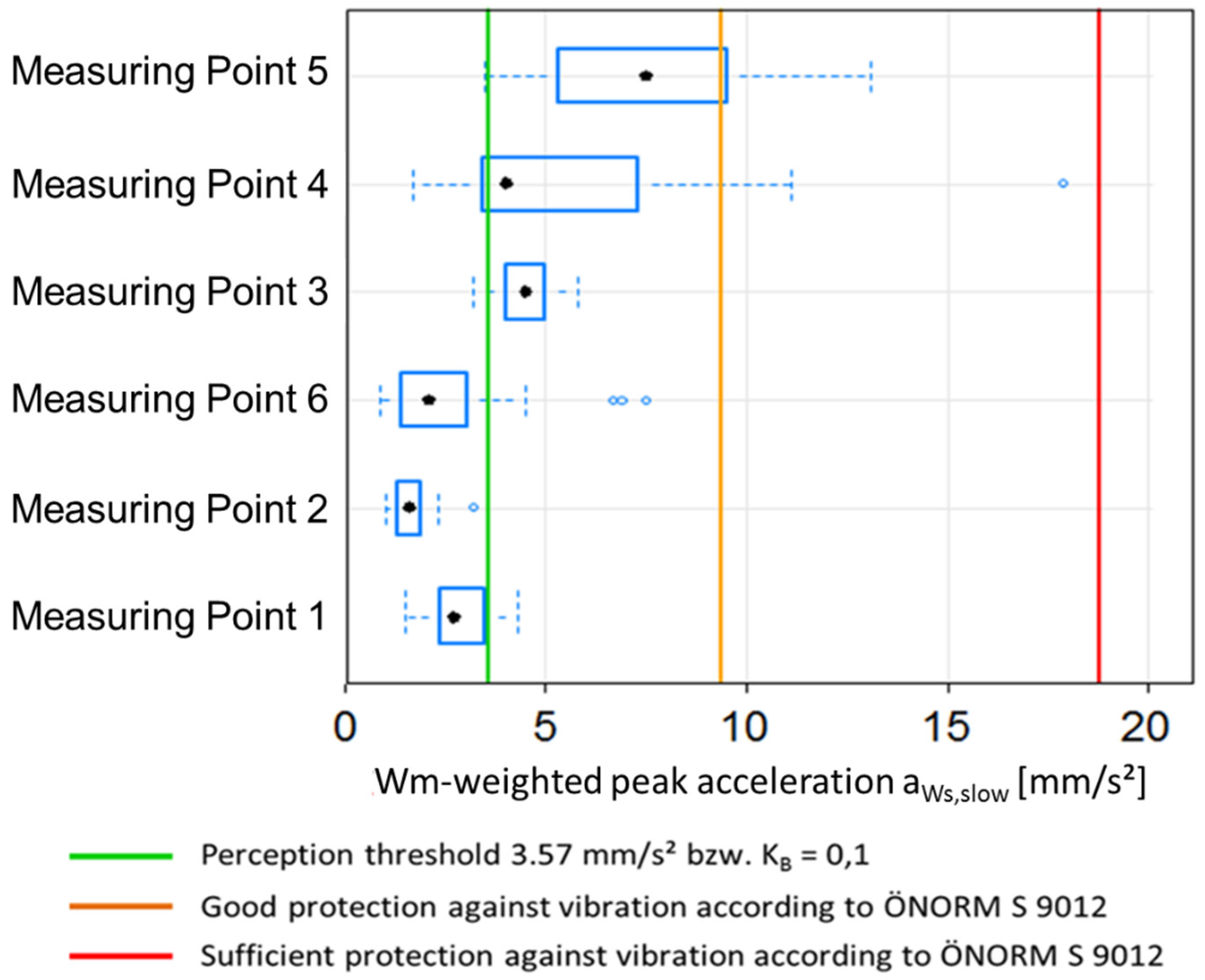
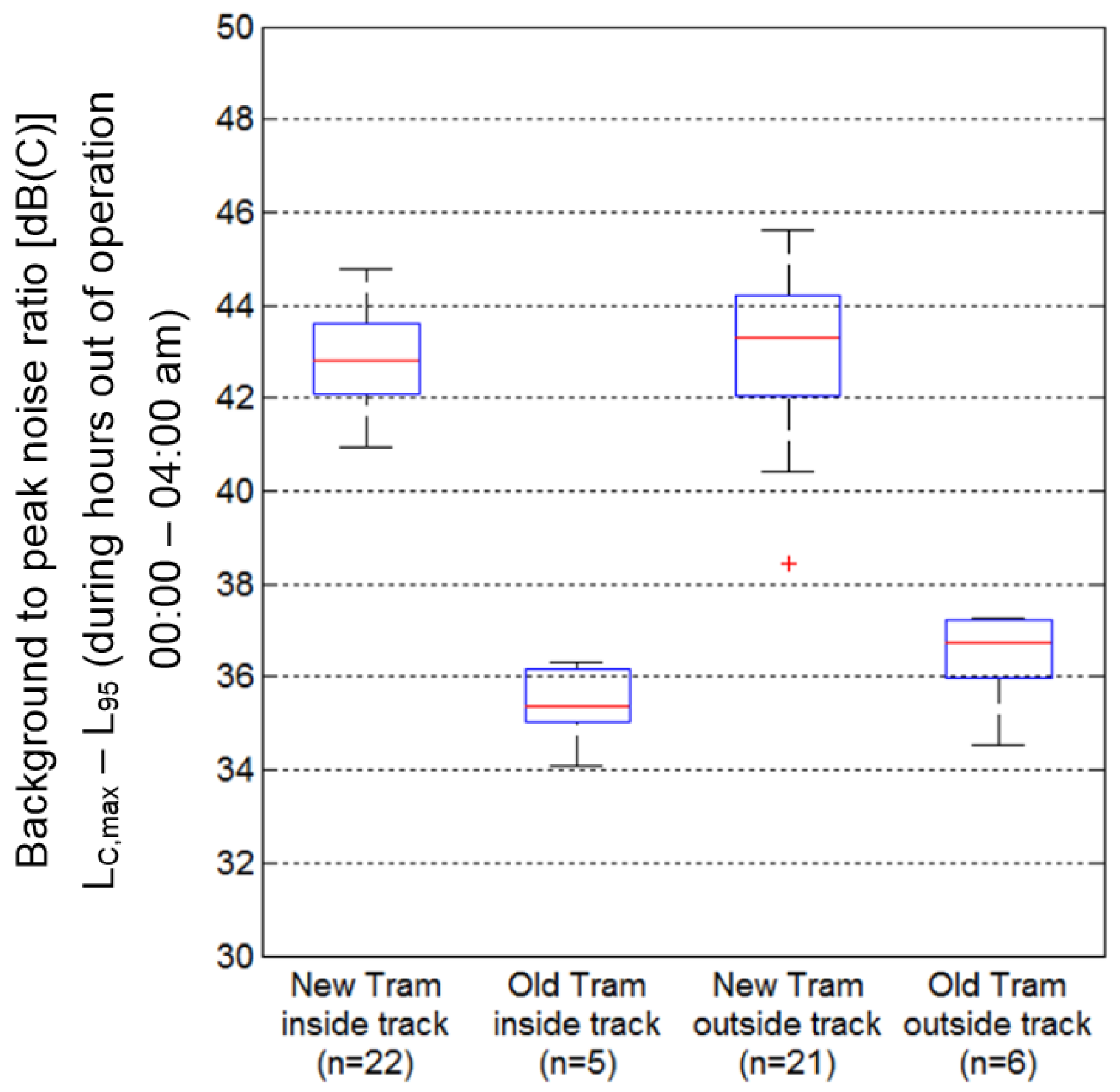
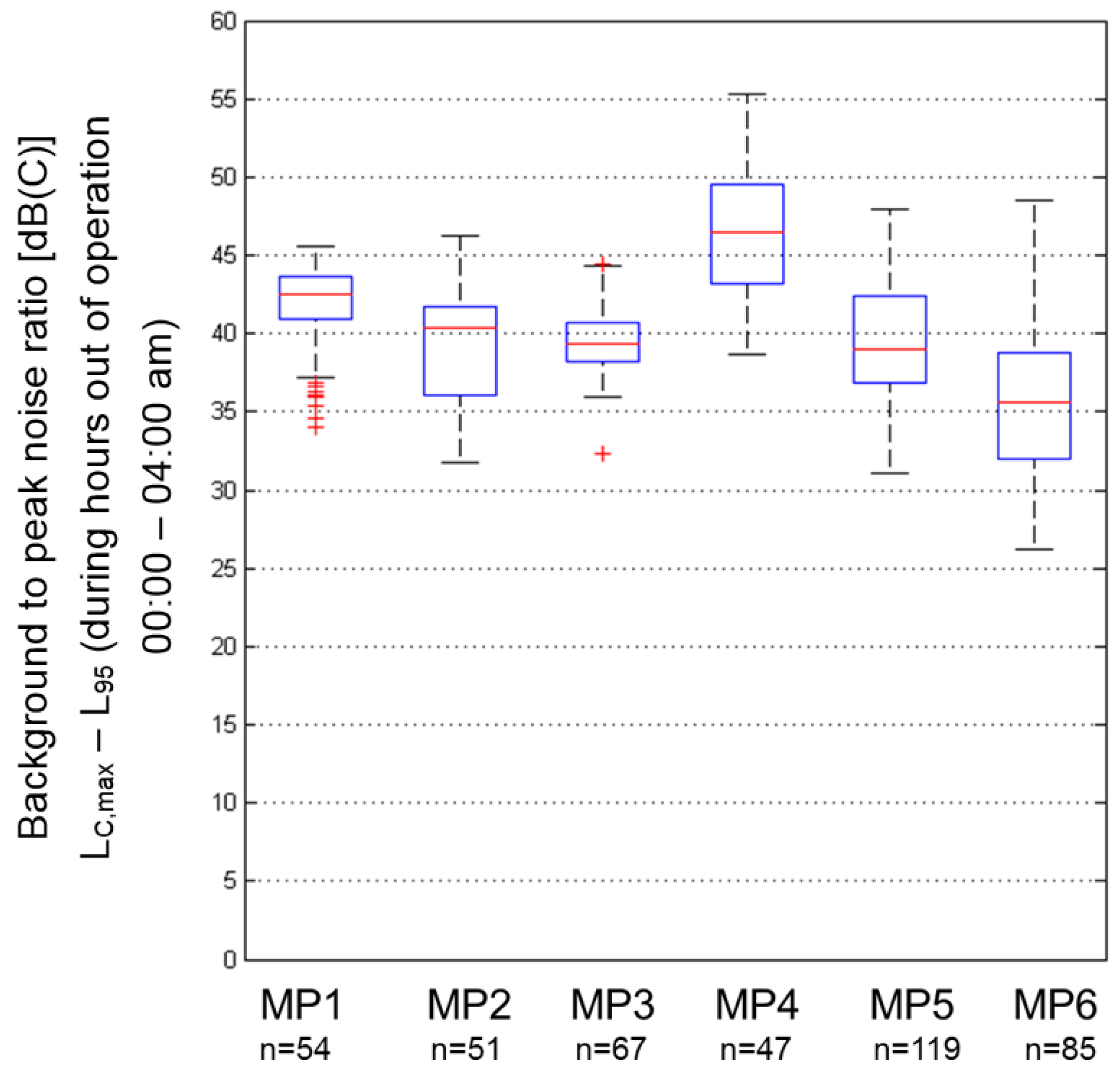
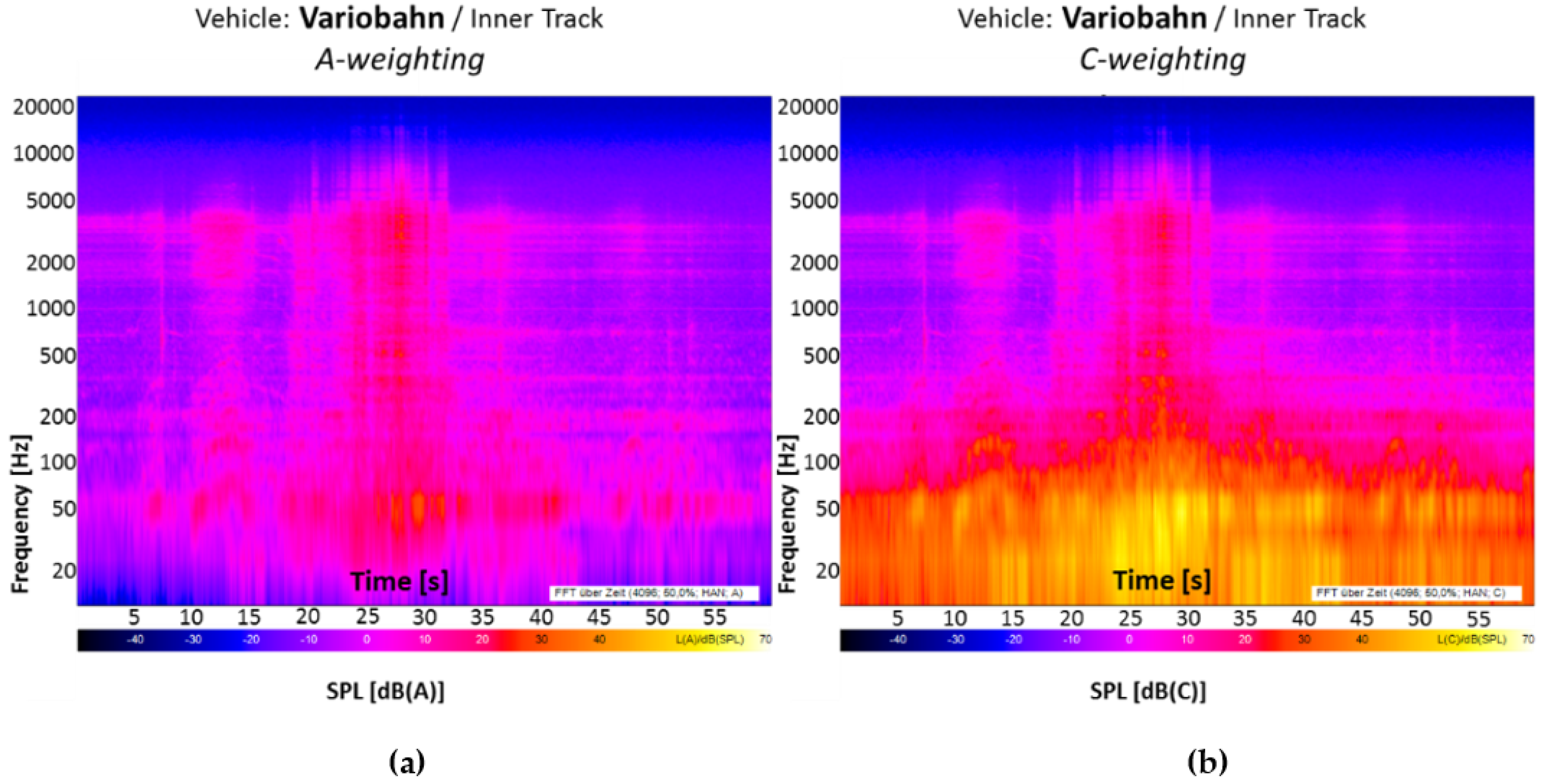
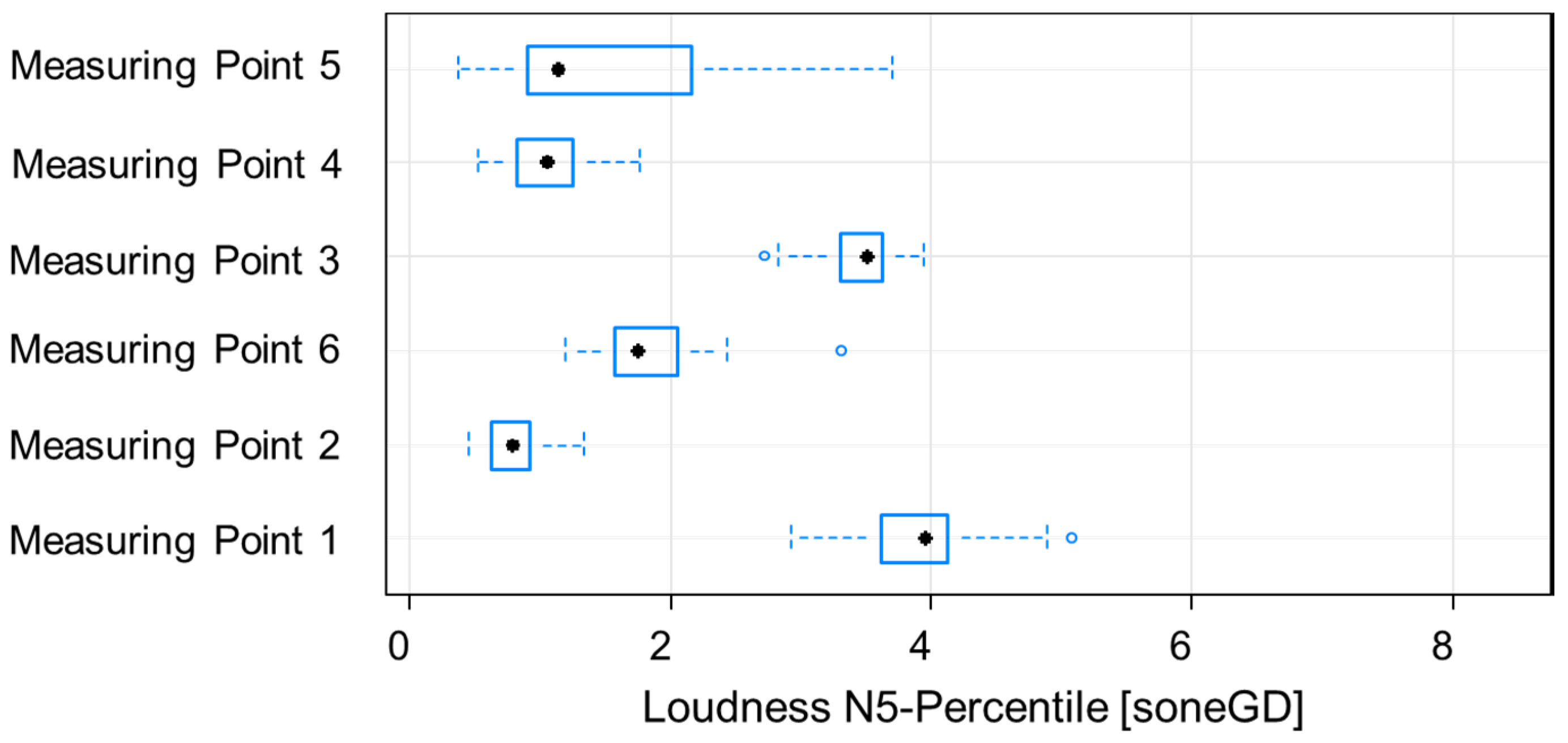
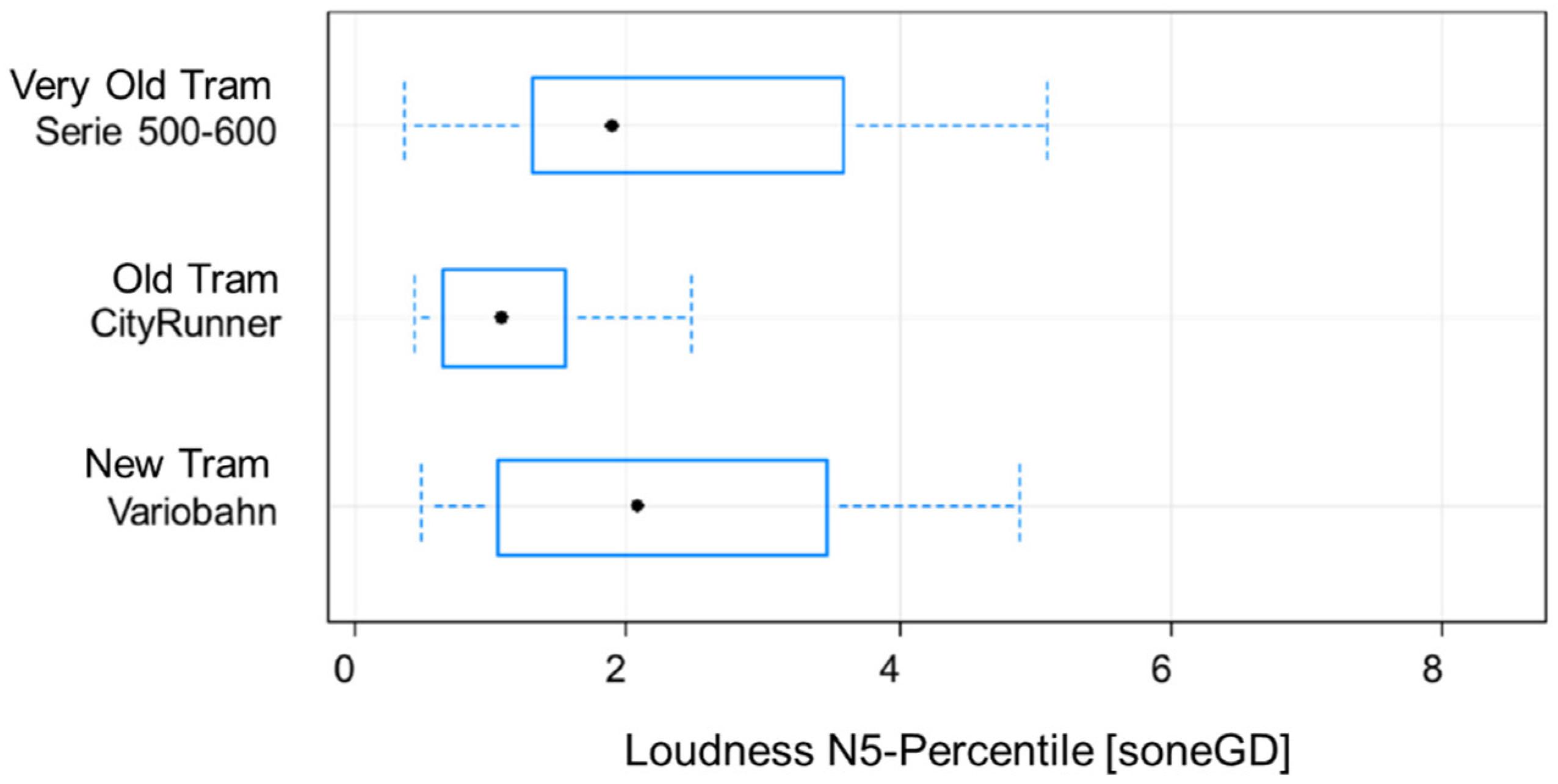

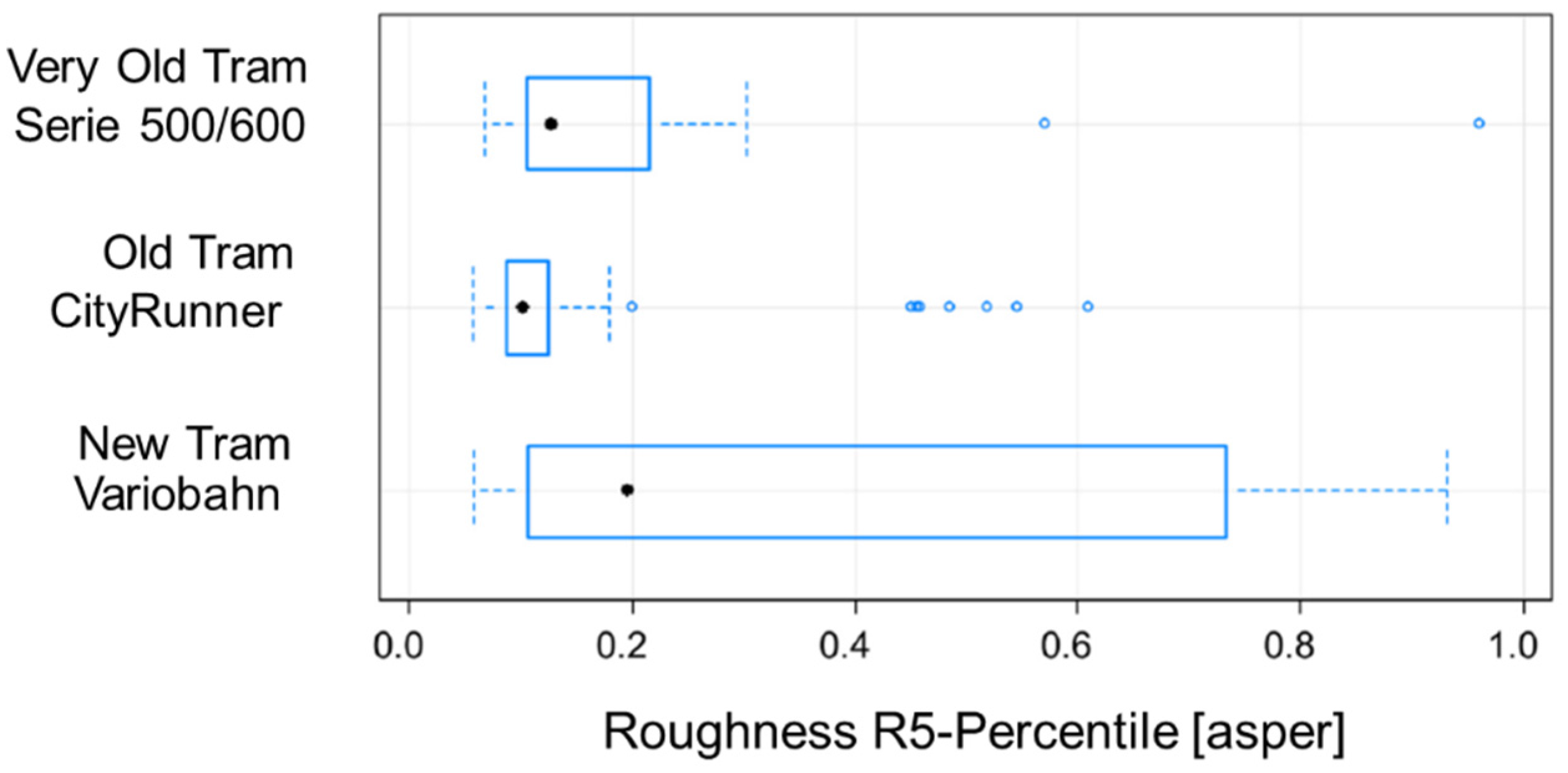
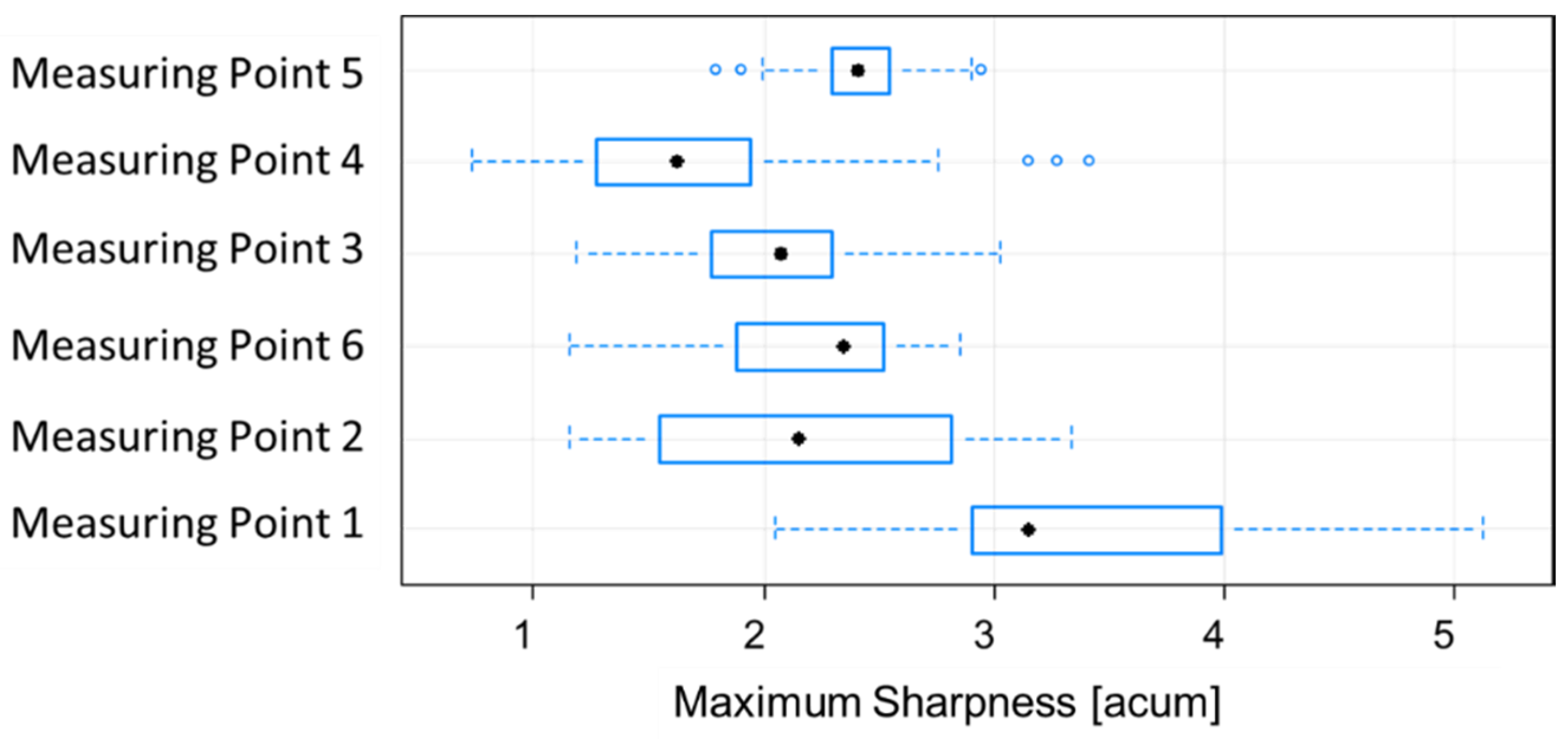
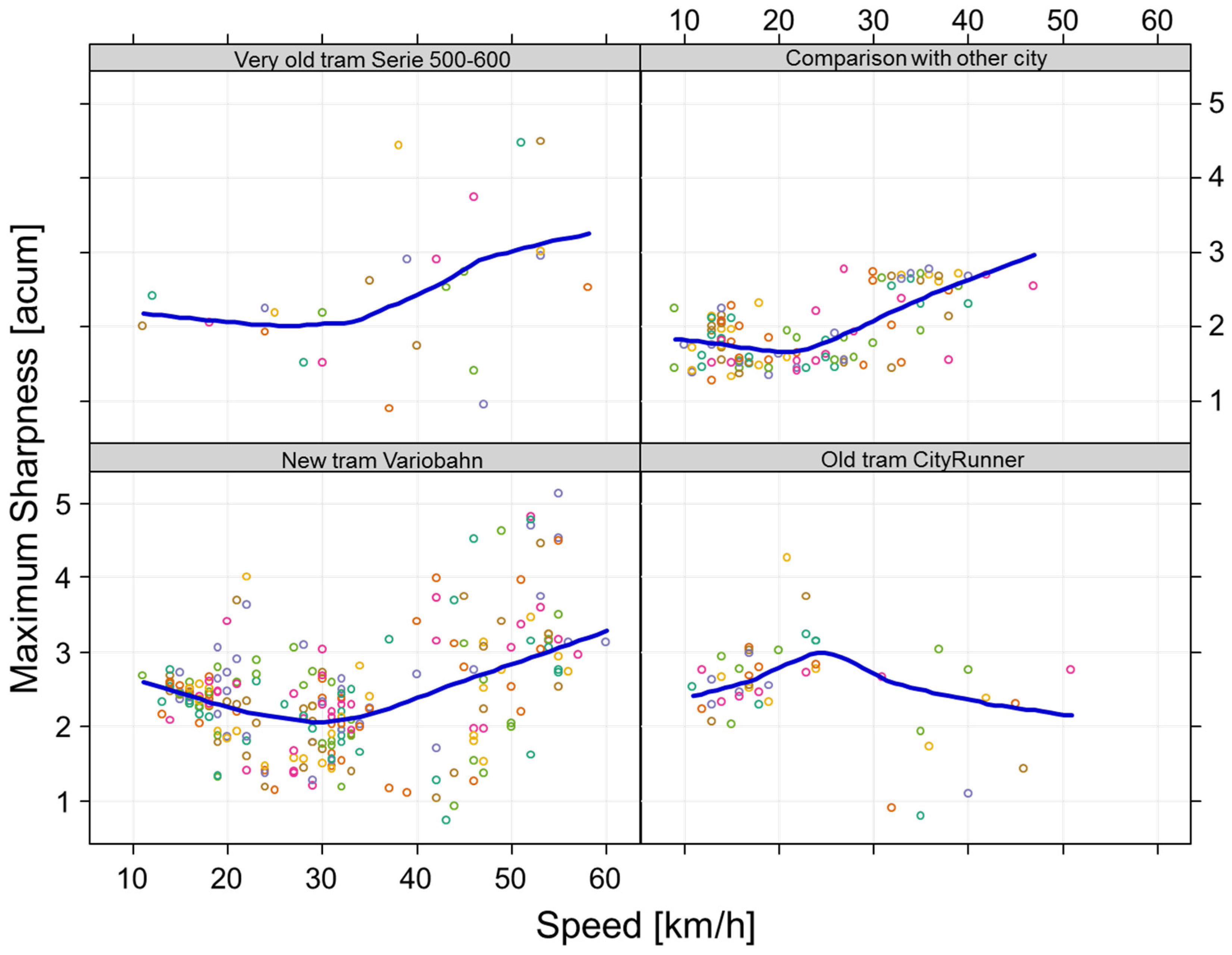
| Measuring Points | Number of Measurements | LAF,max (dB) Mean | LCF,max (dB) Mean | LCF,max (dB) – LAF,max (dB) Mean |
|---|---|---|---|---|
| MP 1 | 54 | 48.4 | 63.8 | 15.4 |
| MP 2 | 51 | 31.5 | 53.8 | 22.3 |
| MP 3 | 67 | 42.3 | 54.1 | 11.8 |
| MP 4 | 47 | 32.6 | 58.2 | 25.6 |
| MP 5 | 119 | 37.1 | 56.9 | 19.8 |
| MP 6 | 85 | 41.6 | 57.9 | 16.3 |
© 2016 by the authors; licensee MDPI, Basel, Switzerland. This article is an open access article distributed under the terms and conditions of the Creative Commons Attribution (CC-BY) license (http://creativecommons.org/licenses/by/4.0/).
Share and Cite
Cik, M.; Lienhart, M.; Lercher, P. Analysis of Psychoacoustic and Vibration-Related Parameters to Track the Reasons for Health Complaints after the Introduction of New Tramways. Appl. Sci. 2016, 6, 398. https://doi.org/10.3390/app6120398
Cik M, Lienhart M, Lercher P. Analysis of Psychoacoustic and Vibration-Related Parameters to Track the Reasons for Health Complaints after the Introduction of New Tramways. Applied Sciences. 2016; 6(12):398. https://doi.org/10.3390/app6120398
Chicago/Turabian StyleCik, Michael, Manuel Lienhart, and Peter Lercher. 2016. "Analysis of Psychoacoustic and Vibration-Related Parameters to Track the Reasons for Health Complaints after the Introduction of New Tramways" Applied Sciences 6, no. 12: 398. https://doi.org/10.3390/app6120398







